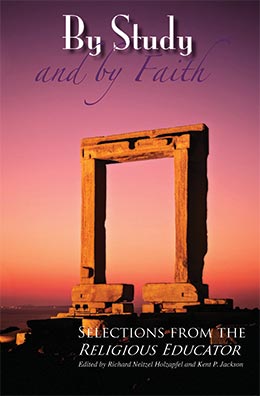"Our Creator's Cosmos"
Neal A. Maxwell
Neal A. Maxwell, “Our Creator’s Cosmos,” in By Study and by Faith: Selections from the Religious Educator, ed. Richard Neitzel Holzapfel and Kent P. Jackson (Provo, UT: Religious Studies Center, Brigham Young University, 2009), 37–50.
Elder Neal A. Maxwell (1926–2004) was a member of the Quorum of the Twelve Apostles when this was published. This address was delivered at the Twenty-sixth Annual Church Educational System Religious Educators Conference on August 13, 2002, at Brigham Young University.
The religious education of our youth and young adults in our seminaries and institutes of religion, our Church schools, and colleges and universities is one of the most effective and high-yield programs of the Church!
While it is your duty to serve the “rising generations,” I am confident that your duty has long since become your delight. Thank you from the bottom of my heart! And thanks to Brother Randy McMurdie, who has helped so much with arranging the special visuals.
My special appreciation goes to Professor Eric G. Hintz of Brigham Young University, an observational astronomer, for his very helpful, substantive suggestions concerning these remarks. Through him I have been pleased to learn of the increasing numbers of Latter-day Saint students pursuing advanced astronomy and astrophysics. For them and all of us, these words of Anselm constitute good counsel: “Believe in order to understand,” rather than “understand in order to believe.” [1] I, and I alone, am responsible for what I say. My theme is “Our Creator’s Cosmos.”
I plead for the vital help of the Spirit as I speak to you as an Apostle, not an astrophysicist. As a special witness, I will speak about the witnessing universe: “The scriptures are laid before thee, yea, and all things denote there is a God; yea, even the earth, and all things that are upon the face of it, yea, and its motion, yea, and also all the planets which move in their regular form do witness that there is a Supreme Creator ” (Alma 30:44; emphasis added).
May what follows—not my words, but the stunning words of scripture along with some breathtaking visuals—bring additional awe and reverence concerning the wonders the Father and Son have wrought to bless us.
Under the Father’s direction, Christ was and is the Lord of the universe, “the same which looked upon the wide expanse of eternity ” (D&C 38:1; emphasis added).
The late Carl Sagan, who communicated effectively about science and the universe, perceptively observed that
in some respects, science has far surpassed religion in delivering awe. How is it that hardly any major religion has looked at science and concluded, ‘This is better than we thought! The Universe is much bigger than our prophets said—grander, more subtle, more elegant. God must be even greater than we dreamed’? Instead, they say, ‘No, no, no! My god is a little god, and I want him to stay that way.’ A religion, old or new, that stressed the magnificence of the Universe as revealed by modern science might be able to draw forth reserves of reverence and awe hardly tapped by the conventional faiths. Sooner or later, such a religion will emerge. [2]
Latter-day Saints certainly should not lack reverence and awe—especially when we contemplate the universe in the context of divinely revealed truths. Yes, the cosmos “as revealed by modern science” is “elegant,” as Sagan wrote. But the universe is also pulsating with divine purpose, so our awe is “added upon,” providing even greater reasons for reverential awe regarding “the magnificence of the Universe”!
Of course, the Church does not align itself with the astrophysics of 2002, nor does it endorse any particular scientific theory about the creation of the universe.
As astrophysicists pursue their important work, they use the scientific method and are not in pursuit of spiritual answers. A few scientists share our belief in religious explanations concerning these vast creations, but some view ours as an unsponsored universe. Bereft of belief in cosmic meaning, some, as portrayed by one writer, view humans as being “wrenched whimpering into an alien universe.” [3]
Resoundingly, the restored scriptures tell us otherwise!
But do the sweeping, scriptural words with which we have been blessed stir us enough? Are we steadily becoming the “manner of people” who reflect such soaring doctrines by our increased spiritual sanctification? Brothers and sisters, God is giving away the spiritual secrets of the universe, but are we listening?
In daily discipleship, we are rightly instructed to “lift up the hands which hang down” (Hebrews 12:12). Why not also strive to “lift up” the sometimes passive and provincial minds that also “hang down,” unnoticing of the stunning scope of it all?
Given all that God has done to prepare a place for us in the stretching universe, might we not develop and display greater faith? In the perplexities and crunches of life, will we have faith in the Creator’s having made “ample provision” to bring all His purposes to pass? [4]
Years ago, President J. Reuben Clark Jr. made this comforting comment: “Our Lord is not a novice, he is not an amateur; he has been over this course time and time and time again.” [5]
Brothers and sisters, has not the Lord described His course as “one eternal round”? (D&C 35:1; see also 1 Nephi 10:19; Alma 7:20; D&C 3:2).
Greater appreciation for the greater universe will also help us to live more righteously in our own tiny universes of daily life. Likewise, a better understanding of God’s governance of the vast galaxies can lead to our better self-governance.
Now for a mixture of scriptures, illustrations, and scientific commentary.
Consider first this photo of our beautiful earth as viewed with our moon in the foreground:

Reflect upon how long it took man to reach the moon, and yet it is located in our own backyard!
The resources so necessary to sustain human life are so generously provided on this particular planet; unless they are mismanaged, we are told that there is “enough and to spare” (D&C 104:17). Yet as big as this earth is—and all of us jet-laggers can so attest—Stephen W. Hawking provided for us some sobering perspective: “[Our] earth is a medium-sized planet orbiting around an average star in the outer suburbs of an ordinary spiral galaxy, which is itself only one of about a million million galaxies in the observable universe.” [6]
One scientist who does not believe in divine design nevertheless noted that “as we look out into the universe and identify the many accidents . . . that have worked together to our benefit, it almost seems as if the universe must in some sense have known that we were coming.” [7]
Arrangements on this earth are apparently more favorable than any in our stretching solar system.

If, for example, the planet earth were closer to the sun, we would fry, and if it were more distant, we would freeze.
Now note the arrow, which points to about where our solar system is situated amid the incredible vastness of our own Milky Way Galaxy.
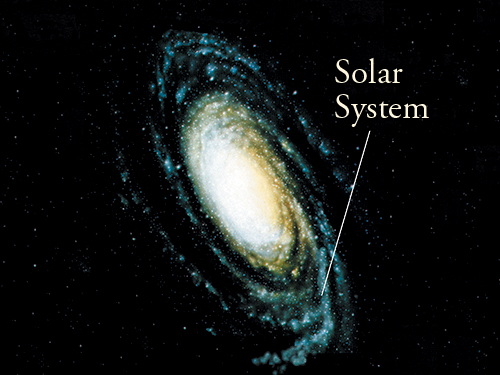
In this visual, though our solar system is stretched out over millions of millions of miles, it is too tiny to see! Oh, the sweeping scope of it all!
On a clear night, you and I can see some portions of the Milky Way, but what if a view of sparkling stars occurred only once every thousand years? Ralph Waldo Emerson wrote of how then “men [would] believe and adore; and preserve for many generations the remembrance of the city of God which had been shown!” [8]
No wonder the scriptures tell how wide and varied God’s witnessing to us is: “Behold, . . . all things are created and made to bear record of [God], . . . things which are in the heavens above, and things which are on the earth . . . : all things bear record of [God] ” (Moses 6:63; emphasis added).
Next, contemplate what constitutes but one section within our vast Milky Way Galaxy:
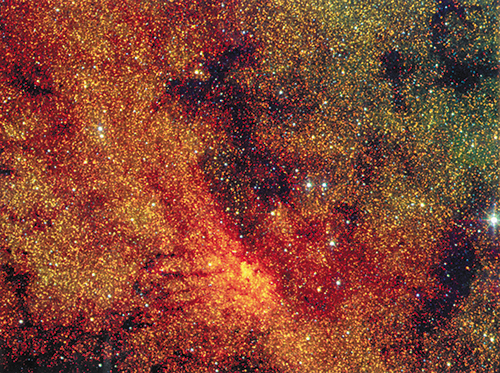
Isn’t it breathtaking? Especially when we realize that the distances between those bright dots are so great!
Whatever the how of God’s creative process, spiritually reassuring things are set forth about the beginning—“back of the beyond,” so very long ago.
“And there stood one among them that was like unto God, and he said unto those who were with him: We will go down, for there is space there, and we will take of these materials, and we will make an earth whereon these may dwell; . . . And they went down at the beginning, and they . . . organized and formed the heavens and the earth” (Abraham 3:24; 4:1; emphasis added).
Strikingly, according to some scientists, “Our galaxy, the Milky Way, is located in one of the relatively empty spaces between the Great Walls.” [9]
There is space there.
As able scientists continue to probe beyond our galaxy with the Hubble space telescope, they discover stunning things like the Keyhole Nebula with its own stars.
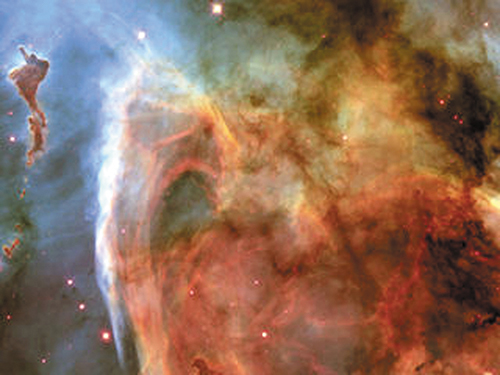
The Hubble telescope has shown us so much more; and, to use one of your students’ favorite words, it is awesome!
This next view is of a star-forming region involving unorganized material.
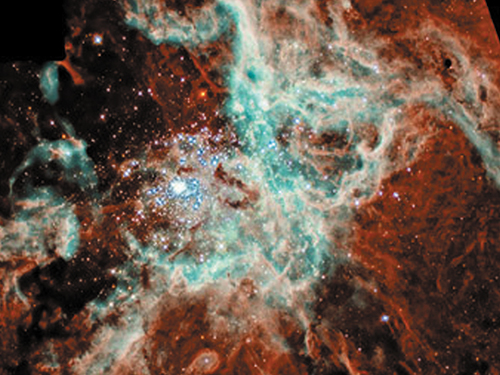 “And as one earth shall pass away, and the heavens thereof even so shall another come” (Moses 1:38).
“And as one earth shall pass away, and the heavens thereof even so shall another come” (Moses 1:38).
Next, we see a visual of what is “left over” after a star dies.
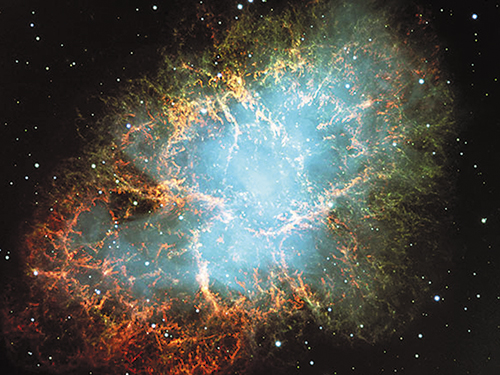 “For behold, there are many worlds that have passed away by the word of my power” (Moses 1:35).
“For behold, there are many worlds that have passed away by the word of my power” (Moses 1:35).
In the words of the hymn “How Great Thou Art,” of the universe and the Atonement, we sing that we “scarce can take it in.” [10]
Whatever God’s initial process, there apparently was some divine overseeing: “And the Gods watched those things which they had ordered until they obeyed” (Abraham 4:18; emphasis added).
Very significantly, we here on this earth are not alone in the universe. In the Doctrine and Covenants, which will be the focus of your study this year, we read that “by [Christ], and through him, and of him, the worlds are and were created, and the inhabitants thereof are begotten sons and daughters unto God” (D&C 76:24; emphasis added; see also Moses 1:35).
We do not know where or how many other inhabited planets there are, even though we appear to be alone in our own solar system.
As to the Lord’s continuing role amid His vast creations, so little has been revealed. There are inklings, however, about kingdoms and inhabitants.
“Therefore, unto this parable I will liken all these kingdoms, and the inhabitants thereof—every kingdom in its hour, and in its time, and in its season, even according to the decree which God hath made” (D&C 88:61).
The Lord even invites us to “ponder in [our] hearts” that particular parable (v. 62). Such pondering does not mean idle speculation, but rather, patient and meek anticipation of further revelations. Besides, God gave only partial disclosure—“not all”—to Moses, with “only an account of this earth” (Moses 1:4, 35), but Moses still learned things he “never had supposed” (v. 10). Nevertheless, we do not worship a one-planet God!
Now, cast your eyes on this view of what is called “deep space”:
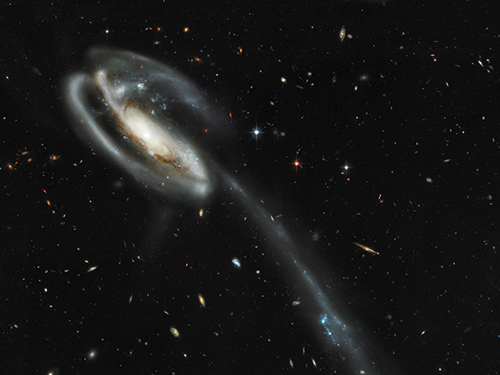
Almost every dot you see in this frame, courtesy of the Hubble telescope, is a galaxy! Think of our own Milky Way Galaxy. I am told that each galaxy represented here has on the order of 100 billion stars. Just this little wedge of the universe has almost innumerable worlds.
Earlier believers in divine design included the articulate Alexander Pope. He reacted thusly to the marvels of this universe:
A mighty maze! but not without a plan. . . .
Thro’ worlds unnumber’d tho’ the God be known,
’Tis ours to trace him only in our own. . . .
[Though] other planets circle other suns. [11]
Happily for us, brothers and sisters, the vastness of the Lord’s creations is matched by the personalness of His purposes!
“For thus saith the Lord that created the heavens; God himself that formed the earth and made it; he hath established it, he created it not in vain, he formed it to be inhabited” (Isaiah 45:18; see also Ephesians 3:9; Hebrews 1:2).
“And worlds without number have I created; and I also created them for mine own purpose; . . .
“. . . For behold, there are many worlds that have passed away by the word of my power. And there are many that now stand, and innumerable are they unto man; but all things are numbered unto me, for they are mine and I know them” (Moses 1:33, 35).
One may ask what is God’s purpose for the inhabitants? It is best expressed in that terse verse with which you are all so familiar: “For behold, this is my work and my glory—to bring to pass the immortality and eternal life of man” (Moses 1:39).
Therefore, in the expansiveness of space, there is stunning personalness, for God knows and loves each of us! (see 1 Nephi 11:17). We are not ciphers in unexplained space! While the Psalmist’s query was, “What is man, that thou art mindful of him?” (Psalm 8:4), mankind is at the very center of God’s work. We are the sheep of His hand and the people of His pasture (see Psalms 79:13; 95:7; 100:3). His work includes our immortalization—accomplished by Christ’s glorious Atonement! Think of it, brothers and sisters, even with their extensive longevity, stars are not immortal, but you are.
The revelations give us very little information about how the Lord created it all. Scientists meanwhile focus on how and what and when. Nevertheless, some of them acknowledge the puzzlement over why. Hawking said: “Although science may solve the problem of how the universe began, it cannot answer the question: Why does the universe bother to exist? I don’t know the answer to that.” [12]
Albert Einstein said of his desires: “I want to know how God created this world. I am not interested in this or that phenomenon, in the spectrum of this or that element. I want to know His thoughts; the rest are details.” [13]
Dr. Allen Sandage, a believer in divine design, was an assistant to Edwin Hubble. Sandage wrote: “Science . . . is concerned with the what, when, and how. It does not, and indeed cannot, answer within its method (powerful as that method is), why.” [14]
Mercifully, we are given vital and pivotal answers to the why questions in revelations that contain the answers that matter most to us anyway! Having seen vast and spectacular things, Enoch rejoiced—but over what? He rejoiced over his personal assurance about God: “Yet thou art there” (Moses 7:30). Enoch even saw God weep over needless human suffering, which tells us so much about divine character (see vv. 28–29). But that is a topic for another time.
Alas, even given the remarkable revelations about the cosmos and God’s purposes, people can still drift away. These people did: “And it came to pass that . . . the people began to forget those signs and wonders which they had heard, and began to be less and less astonished at a sign or a wonder from heaven, insomuch that they began to be hard in their hearts, and blind in their minds, and began to disbelieve all which they had heard and seen” (3 Nephi 2:1).
So, as you and I ponder God’s creative grandeur, we are also told to consider the beauty of the lilies of the field. Remember, “all things” bear witness of Him! (see Alma 30:44).

In this visual we see lilies, and then, in close-up, divine design. The same divine design in the universe is miniatured in the lilies of the field (see Matthew 6:28–29; 3 Nephi 13:28–29; D&C 84:82).

The miracle of this planet has so many ongoing, marvelous subtleties. Wendell Berry writes:
“Whoever really has considered the lilies of the field or the birds of the air and pondered the improbability of their existence in this warm world within the cold and empty stellar distances will hardly balk at the turning of water into wine—which was, after all, a very small miracle. We forget the greater and still continuing miracle by which water (with soil and sunlight) is turned into grapes.” [15]
As we reverence what the Lord has created, we are to reverence Him and His character enough to strive to become ever more like Him, as He has directed (see Matthew 5:48; 3 Nephi 12:48; 27:27). Unsurprisingly, therefore, the power of godliness revealed in lilies is likewise revealed in the ordinances of His gospel (see D&C 84:20). Thematically, these ordinances concern our cleansing, covenanting, obeying, and preparing—all behaviorally necessary in order for us to be empowered to make the homeward journey.
These personalized expressions of divine love and power matter much more to us anyway than trying to number the wondrous galaxies or comparing the number of planets to stars. We lay people could not comprehend it anyway. Achieving spiritual sanctification matters so much more than cosmic quantifications.
Thus, as we enlarge our views both of the universe and of God’s stretching purposes, we, too, can reverently exclaim, “O how great the plan of our God!” (2 Nephi 9:13).
Therefore, as we probe, ponder, and learn, we certainly should be filled with awe, and we should also be intellectually meek. King Benjamin counseled us with these simple but profound words:
“Believe in God; believe that he is, and that he created all things, both in heaven and in earth; believe that he has all wisdom, and all power, both in heaven and in earth; believe that man doth not comprehend all the things which the Lord can comprehend ” (Mosiah 4:9; emphasis added).
Alas, in our age, brothers and sisters, we have some who believe that if they cannot comprehend something, then God cannot comprehend it either. Ironically, some do actually prefer a “little god.” Better for all of us—scientists and nonscientists alike—instead of trying to downsize divinity, to upsize our personal humility!
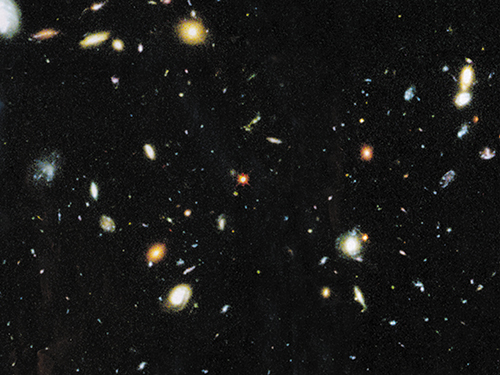
As spectacular as what science has learned about the witnessing universe so far, it is still such a small sample. Of the 1995 Hubble picture of a “deep field,” it was said that “the sampled segment—the deepest image ever taken of the heavens—covered . . . ‘a speck of the sky only about the width of a dime located 75 feet away.’” [16]
The soul trembles, brothers and sisters!
Whatever Moses’ own sample, no wonder he was overwhelmed and “fell unto the earth” saying that “man is nothing” (Moses 1:9–10).
Mercifully, though awestruck, the revelations assure us of God’s love: “Now my brethren, we see that God is mindful of every people, whatsoever land they may be in; yea, he numbereth his people, and his bowels of mercy are over all the earth. Now this is my joy, and my great thanksgiving; yea, and I will give thanks unto my God forever” (Alma 26:37).
So, brothers and sisters, the Lord is mindful of each of His vast creations. Look once more at the many “dots” in just one portion of our ordinary-sized Milky Way Galaxy:
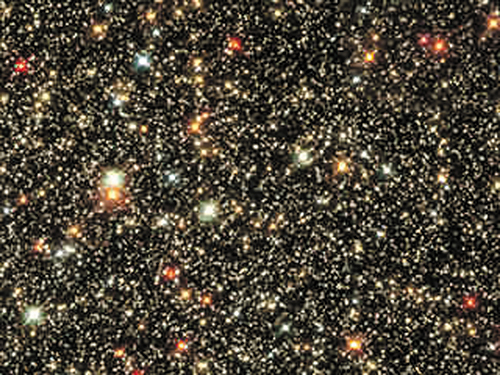
He knows them all. Think of it. Just as the Lord knows each of these creations, so also He knows and loves each of those seen in this or any crowd—indeed, each and all of mankind! (see 1 Nephi 11:17).

Divine determination is so reassuring, as these words in Abraham set forth: “There is nothing that the Lord thy God shall take in his heart to do but what he will do it” (Abraham 3:17). His capacity is so remarkable that two times in two verses in the Book of Mormon He courteously but pointedly reminds us that He really is “able” to do His own work (see 2 Nephi 27:20–21). Is He ever!
Furthermore, order is reflected in God’s creations!
“And I saw the stars, that they were very great, and that one of them was nearest unto the throne of God; and there were many great ones which were near unto it; . . .
“And thus there shall be the reckoning of the time of one planet above another, until thou come nigh unto Kolob, which Kolob is after the reckoning of the Lord’s time; which Kolob is set nigh unto the throne of God, to govern all those planets which belong to the same order as that upon which thou standest” (Abraham 3:2, 9; emphasis added).
One scientist is reported as saying of cosmic configuration, “We may be living among huge honeycomb structures or cells.” [17] Some scientists say of certain nonrandom galaxies that they “appear to be arranged in a network of strings, or filaments, surrounding large, relatively empty regions of space known as voids.” [18] Other astronomers say they have discovered an “enormous . . . wall of galaxies, . . . the largest structure yet observed in the universe.” [19] Commendably, such able scientists continue to press forward.
For us, however, clearly the earth never was the center of the universe, as many once provincially believed! Nor has it been many decades since many likewise believed our Milky Way Galaxy was the only galaxy in the universe.
But the more we know, the more vital the why questions and the answers thereto become. Yet the answers to the why questions are obtainable only by revelations given by God the Creator, and more is yet to come:
“All thrones and dominions, principalities and powers, shall be revealed and set forth upon all who have endured valiantly for the gospel of Jesus Christ.
“And also, if there be bounds set to the heavens or to the seas, or to the dry land, or to the sun, moon, or stars—
“All the times of their revolutions, all the appointed days, months, and years, and all the days of their days, months, and years, and all their glories, laws, and set times, shall be revealed in the days of the dispensation of the fulness of times” (D&C 121:29–31).
Therefore, brothers and sisters, as we look at the universe, we do not see unexplained chaos or cosmic churn. Instead, the faithful see God “moving in His majesty and power” (D&C 88:47). It is like viewing a divinely choreographed, cosmic ballet—spectacular, subduing, and reassuring!
Even so, in the midst of our feeling overcome by the wonder and awe, the “cares of the world” can overcome us (see D&C 39:9). Humdrum routineness and repetition can cause us to look indifferently downward instead of reverently upward and outward. We can become estranged from the Creator, who then seems like a far, distant star: “For how knoweth a man the master whom he has not served, and who is a stranger unto him, and is far from the thoughts and intents of his heart?” (Mosiah 5:13).
We know the Creator of the universe is also the Author of the plan of happiness. We can trust Him. He knows perfectly what brings happiness to His children (see Mosiah 2:41; Alma 41:10).
Meanwhile, as some experience daily life situations in which they are or feel unloved and unappreciated, they can nevertheless know that God loves them! His creations so witness.
Therefore, we can confess His hand in our individual lives just as we can confess His hand in the astonishing universe (see D&C 59:21). If we will so confess His hand now, one day we who are “cradled” amidst His creations can even know what it is like to be “clasped in the arms of Jesus” (Mormon 5:11).
The reverent rejoicing being now encouraged by these remarks was there a long, long time ago. As the Creator’s plan was presented premortally, some even “shouted for joy” (Job 38:7). Why not? For “men are, that they might have joy” (2 Nephi 2:25). May you be blessed to convey to your students the contagion of your reverence and awe concerning the Lord’s creations and His plans for us.
In conclusion, I testify that the astonishing work of God is greater than the known universe. Further, I testify that God’s plans for His children predate His provision of this beautiful planet for us! In the holy name of Jesus Christ, amen.
Notes
[1] Saint Anselm: Basic Writings, trans. Sidney Norton Deane, 2nd ed. (La Salle, IL: Open Court Publishing, 1962), 7.
[2] Carl Sagan, Pale Blue Dot: A Vision of the Human Future in Space (New York: Ballantine Books, 1994), 50.
[3] Morris L. West, The Tower of Babel (New York: William Morrow and Company, 1968), 183.
[4] Joseph Smith, Teachings of the Prophet Joseph Smith, comp. Joseph Fielding Smith (Salt Lake City: Deseret Book, 1976), 220.
[5] J. Reuben Clark Jr., Behold the Lamb of God (Salt Lake City: Deseret Book, 1962), 17.
[6] Stephen W. Hawking, A Brief History of Time: From the Big Bang to Black Holes (New York: Bantam Books, 1988), 126.
[7] Freeman J. Dyson, “Energy in the Universe,” Scientific American 224, no. 3 (September 1971): 59.
[8] Ralph Waldo Emerson, “Nature,” in The Complete Works of Ralph Waldo Emerson, centenary edition, 12 vols. (Boston: Houghton, Mifflin and Company, 1903), 1:7.
[9] Stephen Strauss, “Universe May Have Regular Pattern of Galaxies, New Findings Suggest,” Deseret News, March 4, 1990, 2S.
[10] Stuart K. Hine, “How Great Thou Art,” Hymns (Salt Lake City: The Church of Jesus Christ of Latter-day Saints, 1985), no. 86.
[11] Alexander Pope, “Essay on Man,” in The Poems of Alexander Pope, ed. John Butt (New Haven, CT: Yale University Press, 1963), 504–505.
[12] Stephen Hawking, Black Holes and Baby Universes and Other Essays (New York: Bantam Books, 1993), 99.
[13] Albert Einstein, in Ronald W. Clark, Einstein: The Life and Times (New York: World Publishing Company, 1971), 19.
[14] Allen Sandage, “A Scientist Reflects on Religious Belief,” Truth Journal, Internet edition, vol. 1 (1985), leaderu.com/
[15] Wendell Berry, “Christianity and the Survival of Creation,” in Sex, Economy, Freedom, and Community: Eight Essays (New York and San Francisco: Pantheon Books, 1993), 103.
[16] Michael Benson, “A Space in Time,” Atlantic Monthly 290, no. 1 (July–August 2002): 105.
[17] David Koo, in Strauss, “Universe May Have Regular Pattern,” 2S.
[18] Chaisson and Steve McMillan, Astronomy Today (Englewood Cliffs, NJ: Prentice Hall, 1993), 559.
[19] Corey S. Powell, “Up against the Wall,” Scientific American 262, no. 2 (February 1990): 19.
